Marine Insurance
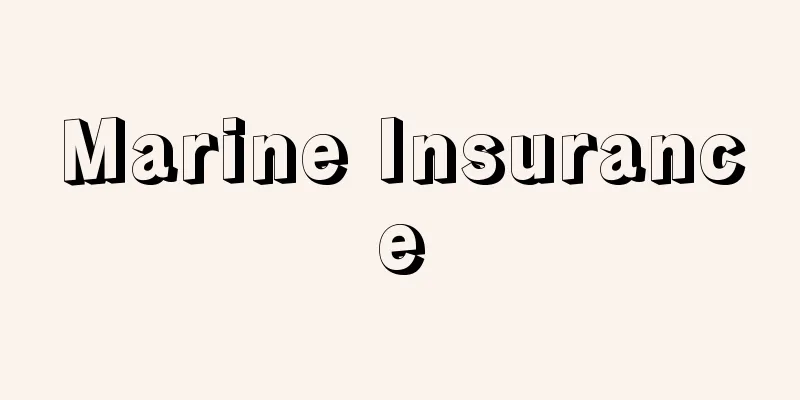
|
Insurance intended to compensate for damages caused by accidents during navigation. [Takuji Kaneko] HistoryMarine insurance has a long history, and its origins can be traced back to ancient Rome. However, it is said that the beginning of modern marine insurance was in the 14th century, when marine insurance contracts were concluded in cities along the Mediterranean coast of northern Italy, which evolved from the previous maritime practice of adventure loans. The contracts concluded in Palermo in 1350, Pisa in 1379, Florence in 1385, and Venice in 1395 all have the form of today's insurance contracts. With the development of Mediterranean commerce, Italian merchants, especially those from Lombardy, became more active, and as their sphere of influence expanded, marine insurance was also introduced from Italy to commercial cities on the North Atlantic coast, such as Lisbon, Bordeaux, and Bruges, via ports on the Mediterranean coast such as Marseille and Barcelona, and eventually Antwerp became the center of trade and marine insurance, replacing the former Italian cities. Marine insurance was then introduced from Antwerp to Amsterdam and Hamburg in the north, and London in the west. From the 17th century onwards, marine insurance became popular, centered around Lombard Street in London, whose name comes from Lombardy. As Britain became a central market for trade and shipping, British marine insurance became a model for other countries around the world and secured a leading position. In Japan, during the Keicho and Genna eras (1596-1624), a type of loan similar to adventure loans called "nagegane" was practiced in the red seal ship trade, and in the Genroku era (1688-1704), a type of loan called marine contracting was practiced, in which shipping agents and shipowners would bear the costs of damage incurred during the transportation of cargo in exchange for a high freight charge. However, neither of these practices developed into an independent insurance system, and the modern marine insurance system was imported from abroad after the Meiji Restoration. When the three ports of Kanagawa, Nagasaki, and Hakodate were opened in 1859 (Ansei 6), insurance companies, along with foreign trading companies, began to move into these ports and do business mainly with foreign companies, and in the Meiji era, they also began to handle marine insurance for Japanese people. In 1873 (Meiji 6), Houninsha was established with a charter from the Hokkaido Development Commission with the goal of developing Hokkaido. It transported cargo between Hakodate, Tokyo and Osaka, as well as related documentary transactions and marine contracting services, but it was not profitable and was dissolved in April of the following year. In 1877, the First National Bank began a "marine acceptance" service limited to documentary transactions between the bank's head office and branches, and in 1879, President Shibusawa Eiichi, with the participation of Iwasaki Yataro of Mitsubishi, founded Tokio Marine Insurance Company (later Tokio Marine & Nichido Fire Insurance, now Tokio Marine & Nichido Fire Insurance) in order to utilize the funds of the former daimyo and aristocracy, and transferred the marine acceptance service to the company. Tokio Marine Insurance Company was Japan's first insurance company. [Takuji Kaneko] Functions and TypesMarine insurance is insurance that aims to compensate for damages caused by sinking, stranding, running aground (a ship on sand or mud), fire, collision, and other perils at sea. For example, if a ship loaded with cargo runs aground during a voyage and the ship and cargo are lost or damaged, the owner of the ship and cargo will naturally suffer damages. And the damages are not limited to the physical damage to the ship and cargo itself. If the shipowner is unable to complete the transportation of the cargo due to the grounding, he cannot claim the freight from the shipper, and as a result, he cannot recover the ship's expenses such as fuel, food, and consumables that were paid for the voyage. The shipowner will also suffer damages by losing the profits that he would have gained if the cargo had safely reached its destination. In addition, if a peril at sea occurs, the shipowner or cargo owner will have to pay damage prevention costs to prevent or reduce damages, and if the shipowner's ship collides with another ship and causes damage to the other ship and its cargo, he will be liable for collision damages. In this way, damages caused by the occurrence of maritime perils include, in addition to physical damage to ships and cargo, damages to positive assets such as the shipowner's right to claim freight, expenses that are planned to be recovered such as ship expenses, and expected profits such as the cargo owner's desired profits, as well as damages to negative assets such as expenses such as damage prevention costs and the shipowner's liability for collision damages. Marine insurance covers all of these types of damages caused by the occurrence of maritime perils. Marine insurance is broadly divided into hull insurance and cargo insurance depending on the subject of the occurrence of maritime peril, i.e., the purpose of the insurance. [Takuji Kaneko] Marine InsuranceThe ship, which is the subject of insurance, is a complex structure, and in addition to the hull, there is the engine, mast, steering gear, etc., which are naturally part of the ship. In addition, all accessories, fuel, food, and other expendables aboard the ship for the purpose of using the ship are also included in the ship, if they are owned by the insured. The insured value of the ship is the value at the time of the commencement of insurance liability under the Commercial Code, and this value binds both contracting parties until the end of the insurance period, so-called insured value immutability is used. However, in order to eliminate disputes over what the value was at the time of the commencement of insurance liability, in practice, the value evaluated between the insured and the insurer at the time of the conclusion of the insurance contract, that is, the agreed insured value, is used. In hull insurance, the insured amount is usually the same as the agreed insured value, and full insurance is provided. In addition, except in the case of a total loss, the insured amount does not decrease even if the insurance company pays the insurance money, and insurance money can be paid any number of times for each accident up to the insured amount. The insurance period is usually one year, but shorter-term contracts can also be made, and the risk of a single voyage can be insured as voyage insurance. The insurance conditions for hull insurance include the general hull insurance clauses, which stipulate the general contract contents, and special clauses (Types 1 to 5) that stipulate the scope of damage compensation. Insurance can be underwritten by selecting one of the special clauses on top of the general clauses. [Takuji Kaneko] Cargo InsuranceSince the cargo that is the subject of the sales contract is transported via land, sea, and air transport routes, there are three types of cargo insurance underwritten in Japan's insurance market: transportation insurance, which mainly covers risks during land transport of cargo, marine cargo insurance (also called cargo insurance), which mainly covers risks during sea transport, and air cargo insurance, which mainly covers risks during air transport. Of these, marine cargo insurance is further classified into ocean cargo insurance, which covers cargo transported internationally (mainly import and export cargo), and coastal cargo insurance, which covers cargo transported along Japan's domestic coasts. Among cargo insurance, there are various differences between coastal cargo insurance and transportation insurance, and ocean cargo insurance, mainly in terms of the underwriting method and applicable law, which arise from the fact that the former two are used for domestic transactions and the latter for international transactions. In other words, for coastal cargo insurance and transportation insurance, all insurance contracts are denominated in yen, and insurance policies or insurance acceptance certificates are issued in Japanese. Furthermore, matters not stipulated in the insurance policy are governed by Japanese laws and regulations. Furthermore, insurance conditions and premium rates are, in principle, determined by the General Insurance Rating Board. In contrast, marine cargo insurance contracts are, in principle, denominated in foreign currency, and insurance policies are issued in English. Furthermore, the liability of insurance companies for insurance claims and settlement are governed by British law and custom. In the UK, the Association of London Insurers' new insurance policy form and new insurance terms have been used since 1982, and Japan is also following suit and is in the process of switching over to the new ones. [Takuji Kaneko] "Kamei Toshiaki, 'Introduction to Marine Insurance,' Revised Edition (1996, Seizando Shoten)" ▽ "Chikami Masahiko, 'Research on the History of Marine Insurance - Marine Insurance Ordinances and the Same Contract Principles in the Mediterranean Period of the 14th and 15th Centuries,' (1997, Yuhikaku)" ▽ "Kato Osamu, 'International Cargo Marine Insurance Practice,' 3rd Edition (1997, Seizando Shoten)" ▽ "Kato Osamu, 'Reform of Trade Cargo Marine Insurance,' (1998, Hakuto Shobo)" [References] | | | & Nichido Fire Insurance | | |Source: Shogakukan Encyclopedia Nipponica About Encyclopedia Nipponica Information | Legend |
|
航海に関する事故によって生ずる損害の填補(てんぽ)を目的とする保険。 [金子卓治] 沿革海上保険の歴史は古く、その萌芽(ほうが)は古代ローマ時代にさかのぼることができるが、14世紀に北部イタリアの地中海沿岸諸都市において、それまでの海事慣行であった冒険貸借より転化して海上保険契約が結ばれるようになったのが現在のような海上保険の始まりとされている。1350年にパレルモ、1379年にピサ、1385年にフィレンツェ、1395年にベネチアで契約されたものは、いずれも今日の保険契約の形をとっている。地中海商業の発展に伴いイタリア商人とくにロンバルディア商人の活動が活発となり、その勢力圏の拡大とともに、海上保険もイタリアからマルセイユ、バルセロナなど地中海沿岸の港を経てリスボン、ボルドー、ブリュージュなど北大西洋岸の商業都市に伝えられ、やがてアントウェルペン(アントワープ)がかつてのイタリアの都市にかわって貿易および海上保険の中心地となるに至った。海上保険はさらにアントウェルペンから、北はアムステルダム、ハンブルクへ、西はロンドンへと伝えられた。そして17世紀以降は、その名もロンバルディアに由来するロンドンのロンバード街を中心として盛んに行われ、さらにイギリスが貿易、海運の中心的市場になるにおよんで、イギリスの海上保険は世界各国の模範となり、指導的地位を確保するようになった。 わが国においても、慶長(けいちょう)・元和(げんな)(1596~1624)ごろの朱印船貿易では「抛銀(なげがね)」という冒険貸借に似たものが行われており、元禄(げんろく)時代(1688~1704)になると、海上請負と称して、廻船(かいせん)問屋や船主が積み荷の運送中に生じた損害を負担するかわりに高い運賃をとることが行われていたが、いずれも独立した保険制度として発展することはなく、近代的な海上保険制度は明治維新後に外国から移入された。1859年(安政6)に神奈川、長崎、箱館(はこだて)の3港が開港されると、外国の貿易会社などとともに保険会社もこれらの港に進出してきて、主として外国会社を相手に営業を始め、明治時代に入ると、日本人を相手とする海上保険も取り扱うようになった。73年(明治6)には、北海道の開発を目的とした保任社が北海道開拓使の特許によって設立され、函館(はこだて)―東京―大阪間の貨物の運送を行うとともに、それに関連する荷為替(にがわせ)と海上請負業務を行ったが、採算がとれず、翌年4月には解散してしまった。77年になると、第一国立銀行が同行の本支店間荷為替の物品に限り「海上受合(うけあい)」業務を始め、79年には、渋沢栄一頭取(とうどり)が旧大名華族の資金を活用するために三菱(みつびし)の岩崎弥太郎の参加を得て東京海上保険会社(のちの東京海上火災保険、現東京海上日動火災保険)を創立し、海上受合業務を同社に譲渡した。この東京海上保険会社がわが国最初の保険会社である。 [金子卓治] 機能と種類海上保険は、沈没、座礁、座州(砂や泥の上に船が乗り上げること)、火災、衝突その他の海上危険によって生ずる損害の填補を目的とする保険である。たとえば、貨物を積載した船舶が航海中に座礁して、船舶や貨物が滅失・損傷すれば、船舶や貨物の所有者は当然に損害を被る。そして損害はこの船舶や貨物自体の物的損害にとどまらず、船主は座礁のために貨物の運送が完了しなければ、荷主に運送賃を請求できず、その結果、その航海のために支出した燃料、食料、消耗品などの船費も回収できないことになる。荷主もまた貨物が無事目的地に到達したならば得られたはずの希望利益を失うという損害を被ることになる。このほか、海上危険が発生すれば、船主や荷主は損害の防止・軽減のために損害防止費用を支出しなければならなくなるであろうし、船主は自船が他船と衝突し、相手船とその貨物に損害を与えれば、衝突損害賠償責任を負担することになる。このように海上危険の発生によって生ずる損害には、船舶や貨物の物的損害のほかに、船主の運送賃請求権のような権利、船費のような回収を予定した支出、荷主の希望利益のような期待した収益などの積極財産に関する損害と、損害防止費用のような費用の支出や船主の衝突損害賠償責任のような責任の負担などの消極財産に関する損害とがある。海上危険の発生によって生ずるこのような各種の損害を填補するのが海上保険である。 海上保険は、海上危険の発生の主体、すなわち、保険の目的によって船舶保険と貨物保険とに大別される。 [金子卓治] 船舶保険保険の目的である船舶は複雑な建造物で、船体のほかに、機関、帆柱、操舵(そうだ)器などがあるが、これらは当然に船舶の一部となる。また、被保険者の所有する物であれば、船舶使用の目的のために船舶内にあるすべての属具、燃料、食料その他の消耗品も船舶のなかに含めている。船舶の保険価額は、商法では保険責任開始のときにおける価額とし、保険期間の終了までこの価額が契約当事者双方を拘束する、いわゆる保険価額不変更の擬制が行われている。しかし、保険責任開始のときの価額がいくらであったかについての争いをなくすために、実際には、保険契約締結時に保険契約者と保険者との間で評価された価額、すなわち、協定保険価額が使用されている。船舶保険では保険金額を協定保険価額と同額とし、全部保険とするのが普通である。また、全損となった場合を除き、保険会社が保険金を支払っても、保険金額が減ることはなく、1回の事故ごとに保険金額を限度として何回でも保険金を支払う。保険期間は多くは1年間の期間保険であるが、短期間の契約も、航海保険として一つの航海の危険を付保することもできる。船舶保険の保険条件には、一般的契約内容を定めた船舶保険普通約款と、損害填補の範囲を定めた第1種から第5種までの特別約款とがあり、普通約款の上に特別約款から一つを選んで付加して引き受けられる。 [金子卓治] 貨物保険売買契約の対象たる貨物は、陸・海・空の運送経路を経て運送される関係上、わが国の保険市場で引き受けられている貨物保険にも、主として貨物の陸上運送中の危険に備える運送保険、主として海上運送中の危険に備える貨物海上保険(積荷保険ともいう)、および主として航空運送中の危険に備える航空貨物保険の3種類がある。このうち、貨物海上保険はさらに、国際間の運送貨物(主として輸出入貨物)を対象とする外航貨物海上保険と、日本の国内沿岸の運送貨物を対象とする内航貨物海上保険とに分類される。貨物保険中、内航貨物海上保険および運送保険と、外航貨物海上保険との間に、前二者が国内取引に利用され、後者が国際取引用に利用されることから生ずる、主として引受方式や準拠法に関する種々の相違が存在する。すなわち、内航貨物海上保険と運送保険では、保険契約はすべて円貨建てで行い、保険証券あるいは保険引受証も和文のものが発行される。そして、保険約款に規定のない事項については日本の法令に従う。さらに保険条件および保険料率は原則上、損害保険料率算定会の決定したものによっている。これに対して、外航貨物海上保険は、保険契約を原則として外貨建てで行い、保険証券も英文のものが発行される。そして、保険金請求に対する保険会社の責任の有無および精算については、イギリスの法律および慣習に準拠する。なお、イギリスでは1982年からロンドン保険業者協会の新しい保険証券の様式、新しい保険約款が使用されることになり、わが国においてもこれに倣って新しいものに切り替えられつつある。 [金子卓治] 『亀井利明著『海上保険概論』改訂版(1996・成山堂書店)』▽『近見正彦著『海上保険史研究――14・5世紀地中海時代における海上保険条例と同契約法理』(1997・有斐閣)』▽『加藤修著『国際貨物海上保険実務』3訂版(1997・成山堂書店)』▽『加藤修著『貿易貨物海上保険改革』(1998・白桃書房)』 [参照項目] | | | | | |出典 小学館 日本大百科全書(ニッポニカ)日本大百科全書(ニッポニカ)について 情報 | 凡例 |
<<: Maritime labor - Kaijoroudou
Recommend
Tokugawa Tadanaga
Year of death: December 6, 10 of Kan'ei (Janua...
Ambilineal descent
…Some researchers define the type of social proce...
gueredon
…Giving something has a binding effect on the rec...
Hancheng (Beijing) - Kanjo
… When the Qing dynasty replaced the Ming dynasty...
Historical records series
A collection of court etiquette and customs. 168 v...
Meganeuropsis
…Protodragonfly insects flourished from the late ...
Cutleria cylindrica
A brown algae belonging to the order Phaeophyceae ...
Urabure - Urabure
...If an exile committed a bad act, he or she wou...
Optical amplifier
An amplifier that can amplify optical signals as ...
Cape pondweed
...In temperate regions such as Japan, it is usua...
Ichinomoto
A district of Tenri City in northern Nara Prefect...
Kuronoseto
A strait between Kuronohama and Nagashima in the n...
Article Management Law - Buppinkanriho
Law No. 113 of 1956. The purpose of this law (Arti...
New moon - Sakubougetsu
The time it takes for the moon to go around the c...
Recurvirostriidae
…A general term for birds in the family Recurviro...





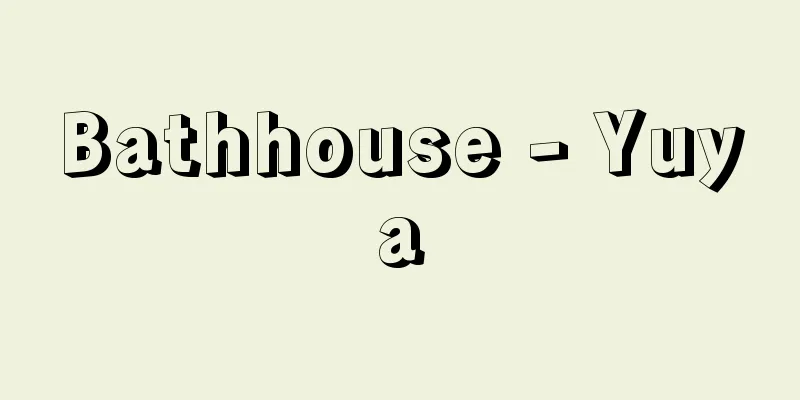
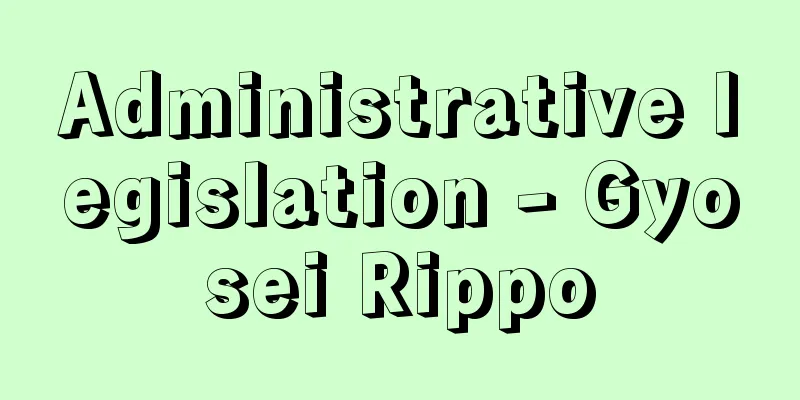
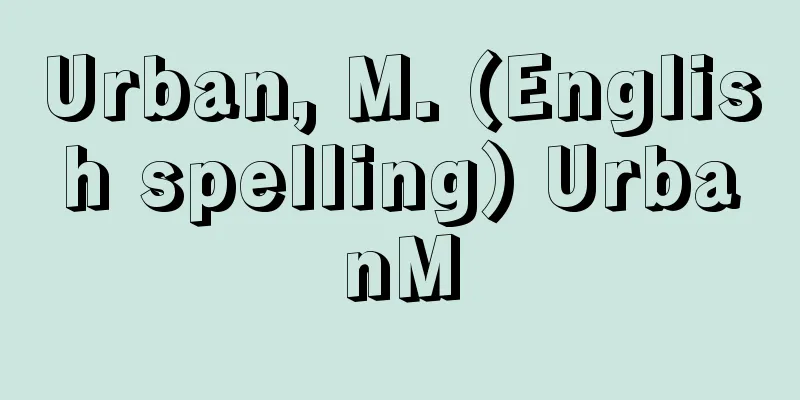
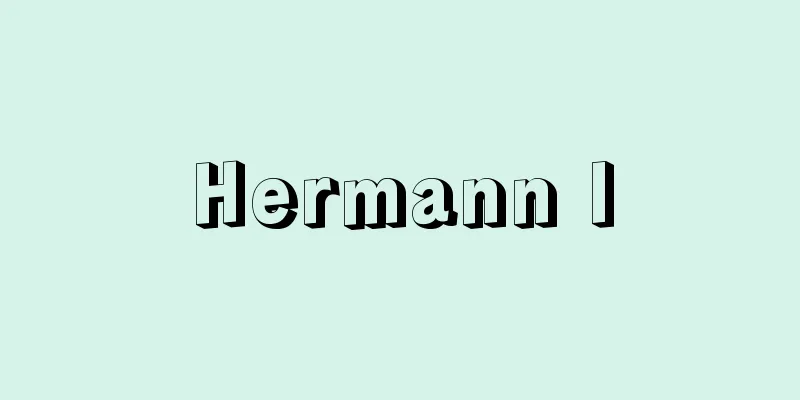
![Taiyo [village] - Taiyo](/upload/images/67cc1aed9fc38.webp)